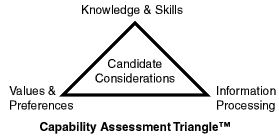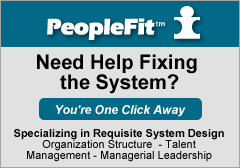Requisite Organization, Organizational Structure, Managerial Leadership, Talent Assessment – Short Articles
By Michelle Malay Carter on August 31, 2010
What Have You Done for Me Lately?
In the blog world, recency is everything! I’ve been going where the energy is lately and that hasn’t been Mission Minded Management.
Truth is Timeless – Requisite Organization
My blog is rooted in the meta-model, Requisite Organization, which focuses upon structuring your organization to take advantage of natural laws. It’s the science behind effective organizations. It informs and enables you to structure your organization, assess and lead your talent with integrity — as an engineer would with a systems, science-based approach. Yes, I’m a management consultant, but I’m really an organizational engineer.
Executive Leadership – Ensuring Strategy Execution, Accountability Systems Design
Lack of a clear framework, which Requisite Organization provides, leads many an executive puzzled by why s/he can’t get her strategy executed. When you design your leadership systems without the common inherent conflicts of interest that exist in most leadership systems, buy-in happens naturally. People want to contribute at work. Requisite Organization’s Accountability and Authority framework integrates these two ideas into a leadership system of integrity.
Major Short Article Repository – Requisite Organization, Organizational Structure, Managerial Leadership, Talent Assessment
While I won’t be posting anymore, please enjoy this repository of short articles. Thank you for your support over the years. And, as always…
I’m OK. You’re OK. Let’s fix the system.
Filed Under Accountability, Executive Leadership, Managerial Leadership, Organization Design, Requisite Organization, Strategy, Talent Management | Comments Off on Requisite Organization, Organizational Structure, Managerial Leadership, Talent Assessment – Short Articles
Comparing and Contrasting Problem Solving Capability – Continued
By Michelle Malay Carter on June 15, 2010
 As a continuation to my last posts which looked at levels one, two, and three, today we will add level four. Notice how not only does the problem solving pattern change, but also and in parallel, the types of organizational problems addressed at this level are different as well.
As a continuation to my last posts which looked at levels one, two, and three, today we will add level four. Notice how not only does the problem solving pattern change, but also and in parallel, the types of organizational problems addressed at this level are different as well.
Context
The sister truth to the fact that work exists in levels is that human problem solving capability exists in levels as well. Therefore, a level one job will be a best fit for someone who is currently capable of level one problem solving. This reality is a core component of Elliott Jaques’ Requisite Organization model.
How Do Problem Solving Levels Compare?
Level One
I follow procedures and training to create products or deliver services to specification. I make judgments about whether something meets the spec or not. I solve problems only after I encounter them. I work to overcome problems via trial and error.
Level Two
My end product cannot be fully specified. As I work, I accumulate information and add that together to form a hypothesis and make judgments about the best course of action necessary to either head off an impending issue or to correct a current issue.
Level Three
My end product may likely be a process or the implementation of a new or better way. As I work, I must use my judgment to plan and execute at least three serial and contingent steps to get to the end goal. (First I must do A because it will lead to B, which puts me in a position for C) I am no longer solving only today’s issue. I must solve today’s problem while considering and/or moving toward a future state.
Level Four
My end product may now become a system. As I work, I must build comprehensive solutions that balance and integrate multiple serial pathways that are contingent upon one another. I can no longer optimize only my area but rather must work across departments and/or functions. I can no longer focus upon tweaking current operations but rather identify gaps between the five year vision and current operations and systematically bring about entirely new ways, products, markets, clientele, and/or infrastructure to meet the vision.
I’m OK. You’re OK. Let’s fix the system.
Filed Under Requisite Organization | Comments Off on Comparing and Contrasting Problem Solving Capability – Continued
Comparing and Contrasting Problem Solving Capability – Continued
By Michelle Malay Carter on June 4, 2010
 As a continuation to my last post which looked at levels one and two, today we will add level three. Notice how not only does the problem solving pattern change, but also and in parallel, the types of organizational problems addressed at this level are different as well.
As a continuation to my last post which looked at levels one and two, today we will add level three. Notice how not only does the problem solving pattern change, but also and in parallel, the types of organizational problems addressed at this level are different as well.
Context
The sister truth to the fact that work exists in levels is that human problem solving capability exists in levels as well. Therefore, a level one job will be a best fit for someone who is currently capable of level one problem solving. This reality is a core component of Elliott Jaques’ Requisite Organization model.
How Do Problem Solving Levels Compare?
Level One
I follow procedures and training to create products or deliver services to specification. I make judgments about whether something meets the spec or not. I solve problems only after I encounter them. I work to overcome problems via trial and error.
Level Two
My end product cannot be fully specified. As I work, I accumulate information and add that together to form a hypothesis and make judgments about the best course of action necessary to either head off an impending issue or to correct a current issue.
Level Three
My end product may likely be a process or the implementation of a new or better way. As I work, I must use my judgment to plan and execute at least three serial and contingent steps to get to the end goal. (First I must do A because it will lead to B, which puts me in a position for C) I am no longer solving only today’s issue. I must solve today’s problem while considering and/or moving toward a future state.
I’m OK. You’re OK. Let’s fix the system.
Filed Under Requisite Organization | Comments Off on Comparing and Contrasting Problem Solving Capability – Continued
An Employee Best Fit Model – The Capability Assessment Triangle
By Michelle Malay Carter on May 10, 2010
 Best Fit Model – PeopleFit’s Capability Assessment Triangle
Best Fit Model – PeopleFit’s Capability Assessment Triangle
How?do managers go about finding the best fit between employee and role?? Most look at resumes and use behavioral based interviewing, but these?items only get at what someone has already had a chance to do.? With research showing that 20 % of employees are underutilized, we a leaving a lot of potential untapped because we don’t have a way to reliably determine potential capability.
I will propose adding a third qualifier to the two most common sets of qualifiers:
Can
1.? Knowledge, skills, experience, education – what can I do because I’ve done it before?
Will
2.? Values, preferences?- what will I do because I find it appealing?
The Missing Link
Area number three, problem solving capability, answers the question that behavioral based interviewing misses – what could I do if I had aforementioned items number 1 and 2?? It has to do with one’s potential capability.
Could
3.? Problem solving capability (information processing)?- what could I do because my mental bandwidth can contain it?
Coming Next?
What does problem solving capability look like by level and how does that align with work levels?
I’m?OK.? You’re OK.? Let’s fix the system.
Filed Under Employee Engagement, High Potential, Managerial Leadership, Requisite Organization, Talent Management, Work Levels | 3 Comments
Talent Assessment – Easy Peasy?
By Michelle Malay Carter on May 6, 2010
It’s?easy to walk on water when you know where the rocks are.??? –? Gerry Kraines
I’ve found that managers are highly capable of assessing the relative cognitive capability (by work level) of their employees when they are given a work levels framework.
People Are Different, and It’s Not Just about Experience and Education
If you are an experienced?manager of multiple people, you know there are differences in mental bandwidth, and this characteristic is irrespective of years of experience, education, training and skill sets.? Meaning, there are assignments you would give to one employee, that you would not give to another, and the bigger assignment does not always go to the employee with more experience or more education.? So what makes the difference?? I would argue it is their current problem solving capability (which increases over time but at different rates in individuals).
The Theory Base
Elliott Jaques, who discovered this phenomenon and incorporated it into his Requisite Organization meta-model, called this capability, complexity of information processing.? It’s the way that?one groups, massages, chews on, and uses information to solve problems, i.e. work.? Think mathematics.? First I add single digits.? Then double.? I move on to subtraction, multiplication, division and then algebra.? If you try to teach these subjects before the student is ready, it doesn’t “compute”.
In my next post, I will begin to spell out what problem solving looks like at the different levels.? With these rocks visible, you may be able to walk on talent assessment water farily quickly.
I’m OK.? You’re OK.? Let’s fix the system.
Filed Under High Potential, Managerial Leadership, Requisite Organization, Talent Management, Work Levels | Comments Off on Talent Assessment – Easy Peasy?
Why You Shouldn’t Hire the Best and the Brightest Candidate
By Michelle Malay Carter on May 5, 2010
 Instead of focusing on hiring the best and the brightest candidate that applies for your position, shouldn’t you focus on hiring the best match?
Instead of focusing on hiring the best and the brightest candidate that applies for your position, shouldn’t you focus on hiring the best match?
The Dangers of Overhiring
Focusing on hiring the brightest candidate can lead to overhiring, which, unless you are building bench for growth, creates drag in the system over time.
Back to Work Levels
I think the ‘best and brightest’ default strategy is compensatory for the fact that we really don’t understand how to match employees to roles.? Although we intuitively know some roles are more complex than others, most lack a clear model that elucidates the universal differences in job complexity.
Problem Solving Pattern
Understanding how the work in the roles is different is a stepping stone toward thinking about the human side – the problem solving capability needed to be successful in the various levels of roles.
Talent Assessment
In my next posts, I will describe the differences in problem solving patterns.? Understanding the patterns is a key managerial leadership knowledge set which is?essential for?accurate talent assessment.
Have you ever overhired?? How long was it before you stopped congratulating yourself for a great hire, and started kicking yourself for the mistake you made?? My guess:?Six months
I’m OK. You’re OK. Let’s fix the system.
Filed Under High Potential, Managerial Leadership, Requisite Organization, Talent Management, Work Levels | 10 Comments
Why Training Rarely Solves The Problem- I’m OK. You’re OK. Let’s Fix the System
By Michelle Malay Carter on March 29, 2010
 Management’s Magic Bullet – Training
Management’s Magic Bullet – Training
Training is a fabulous thing – if people need to build knowledge and skills.
But how often are issues at work really caused by someone’s lack of knowledge or skill?
What does training NOT address?
-
What the accountabilties of my role are, AND what the accountabilities of others’ roles are.
-
Whether I have the explicit requisite authority to carry out those accountabilties.
-
Whether my authorities that I have in relation to others who do not work for me have been shared with those over whom I have authority.
-
When others to whom I do not report have authority over me.
-
A clear, integrated context set for me by my manager within which my peers and I can make clear trade off and priority decisions.
-
Whether I have the resources necessary to do my job.
-
Whether I have the raw cognitive capacity to do my job (regardless of training or desire)
-
Whether I value the work of my role and are willing to commit my energy to it.
-
Whether my manager has the raw cognitive capacity to set context for me and add value to my thinking.
-
Whether my manager values managerial leadership behaviors rather than just the “technical” side of his role.
-
Whether the vertical structure of my organization is requisitely designed to cover all the levels of work with exactly one role within a reporting chain.
-
Whether there are systems in place to support the proper exercising of accountability and authority.
-
Whether the system rewards only output or both output?and effectiveness.
Have you been sent to training that was a clear waste of your time?? When you returned, did you say, I’m OK.? You’re OK.? Let’s fix the system?
Filed Under Accountability, Managerial Leadership, Requisite Organization, Talent Management, Work Levels | 7 Comments
Undercover Boss – Well-Meaning Window Dressing
By Michelle Malay Carter on March 1, 2010
 I must admit I’m touched by the hearts of the CEOs who agree to go undercover to experience their organization on the ground floor.? They seem to geniunely care about the people, not just the publicity afforded to their organization by the show.
I must admit I’m touched by the hearts of the CEOs who agree to go undercover to experience their organization on the ground floor.? They seem to geniunely care about the people, not just the publicity afforded to their organization by the show.
Systems Drive Behavior
However, in the end, their righting single incidents or donating toward a personal financial burden of an employee simply perpetuates the idea that good intentions with a handful of feel-good outcomes makes everything right.? Systems drive behavior!? If you don’t tend to the dysfunctional systems, the dysfunctional behaviors will continue.
Managers Are Accountable for the Output of Their Employees
In the show, when these CEOs come upon a manager who is failing in his/her managerial leadership duties, the CEO usurps the authority of their accountable manager by taking action directly with the manager.? To add to that, the action takes the form of “be nice now”, and as the camera fades over grateful smiles and joyful tears, everyone appears to live happily ever after.??
Creating an Accountability Leadership Culture
A clear, requisite framework of accountabilities and authorities would do more for these workplaces than all the good intentions and fatherly advice we see.
Managers-Once-Removed Should Be Accountable to Identify Talent
The CEOs often identify promising young talent, and at least once, a Training Future Leaders program is set up, but it begs the question, who is accountable for identifying talent and what is it that we are looking for?? And is it all about training?
A System for Talent Assessment and Management
An understanding of work levels could create a science-based foundation for fair and consistent talent assessment and management system.
Call Me!
So I’m sending a shout out to Larry O’Donnell of Waste Management, Coby Brooks of Hooters, Joe DePinto of 7-Eleven, and Dave Rife of White Castle:?? You’re OK.? Your employees are OK.? Let’s fix the system!? It’s clear you have both a head and a heart.? Let’s put them to use toward designing systems!
Executive Leadership Defined
Creating and tending to the system is executive level work.? Through this, you ensure your operational organization is designed correctly and a leadership system is in place to ensure employees have what they need.? PeopleFit can provide you a framework from which you can make informed and intentional decisions in the areas of organizational structure, talent management and managerial leadership systems.
Filed Under Accountability, Employee Engagement, Executive Leadership, High Potential, Organization Design, Requisite Organization, Talent Management, Work Levels | 6 Comments
Measuring Employee Performance Tells as Much about the System as It Does the Employee
By Michelle Malay Carter on February 19, 2010
 In addition to old-fashioned happenstance, there are three main areas of influence over one’s performance within an organization:
In addition to old-fashioned happenstance, there are three main areas of influence over one’s performance within an organization:
Three Areas of Influence over Employee Performance
1. The first is the person’s capability profile which is composed of
a) knowledge, skills and experience,
b) values, temperament and inhibitors, as well as
c) current cognitive capacity.
2. The second is the employee’s manager’s capability profile, composed of the aforementioned items.
3. The third is the system!? i.e. Organizational processes, policies, structure or lack thereof.
Measuring Performance Only Tells a Piece of the Story
This is why we must judge employee effectiveness in light of circumstances.? Measuring performance only is patently unfair, as it never tells the whole story.? When you measure performance, you are also measuring the system within which the employee is working.? Designing the system is executive level work.?
Engage the System to Engage the Employees
Don’t forget.? Without fairness, you will not have engagement.? If you want engagement, stop trying fix your employees and take a look at your system.
I’m OK.? You’re OK.? Let’s fix the system.
Filed Under Accountability, Corporate Values, Employee Engagement, Executive Leadership, Organization Design, Requisite Organization | 3 Comments
How To Interview Your Prospective Boss for Leadership Potential
By Michelle Malay Carter on February 6, 2010
 Let’s face it – your boss can make or break your work experience.? S/he provides you context (aka the big picture), gives you your assignments, provides your resources, integrates your work with your peers, assesses your performance and helps build your skills in your current role.?
Let’s face it – your boss can make or break your work experience.? S/he provides you context (aka the big picture), gives you your assignments, provides your resources, integrates your work with your peers, assesses your performance and helps build your skills in your current role.?
Because of this, when you are interviewing for a job you must take as much care to learn about your prospective manager as you do the prospective job.
Here are some quotes from First, Break All the Rules:
“We had discovered that the manager ? not pay, benefits, perks or a charismatic corporate leader ? was the critical player in building a strong workplace. ?The manager was the key.”
“But it is her relationship with her immediate manager that will determine how long she stays and how productive she is while she is there.?
Time Span Again
Just as I suggested you feature time spans on your resume to signal the level of work for which you are capable, you can use time span as a tool for interviewing your prospective boss.
How to Interview Your Prospective Boss
First, think about the length of projects that feel comfortable to you.? Would you feel comfortable accepting an 18 month deliverable?? How about three years?
Once you have a comfort target in mind, ask your prospective manager about his/her work.? Ask about the longer term goals and projects that s/he is working on.? If the work is not of longer time spans than that which you feel comfortable, this can point to disaster!? Either you are not interviewing for the right level role or your manager is not working at a high enough level or both.
The Experience Fallacy
Remember, more years experience does not automatically qualify someone to be a thought leader for you, and you want your manager to be a thought leader!? One of the most basic needs we have from our manager is the ability for him/her to build context for us.? When your manager does not have more raw mental bandwidth than you do, s/he will not provide you satisfying leadership.
I’m OK.? You’re OK.? Let’s fix the system.
Did you ever know?during the interviewing stage?that the hiring manager would not be a leader for you?
Filed Under Employee Engagement, Managerial Leadership | 4 Comments


